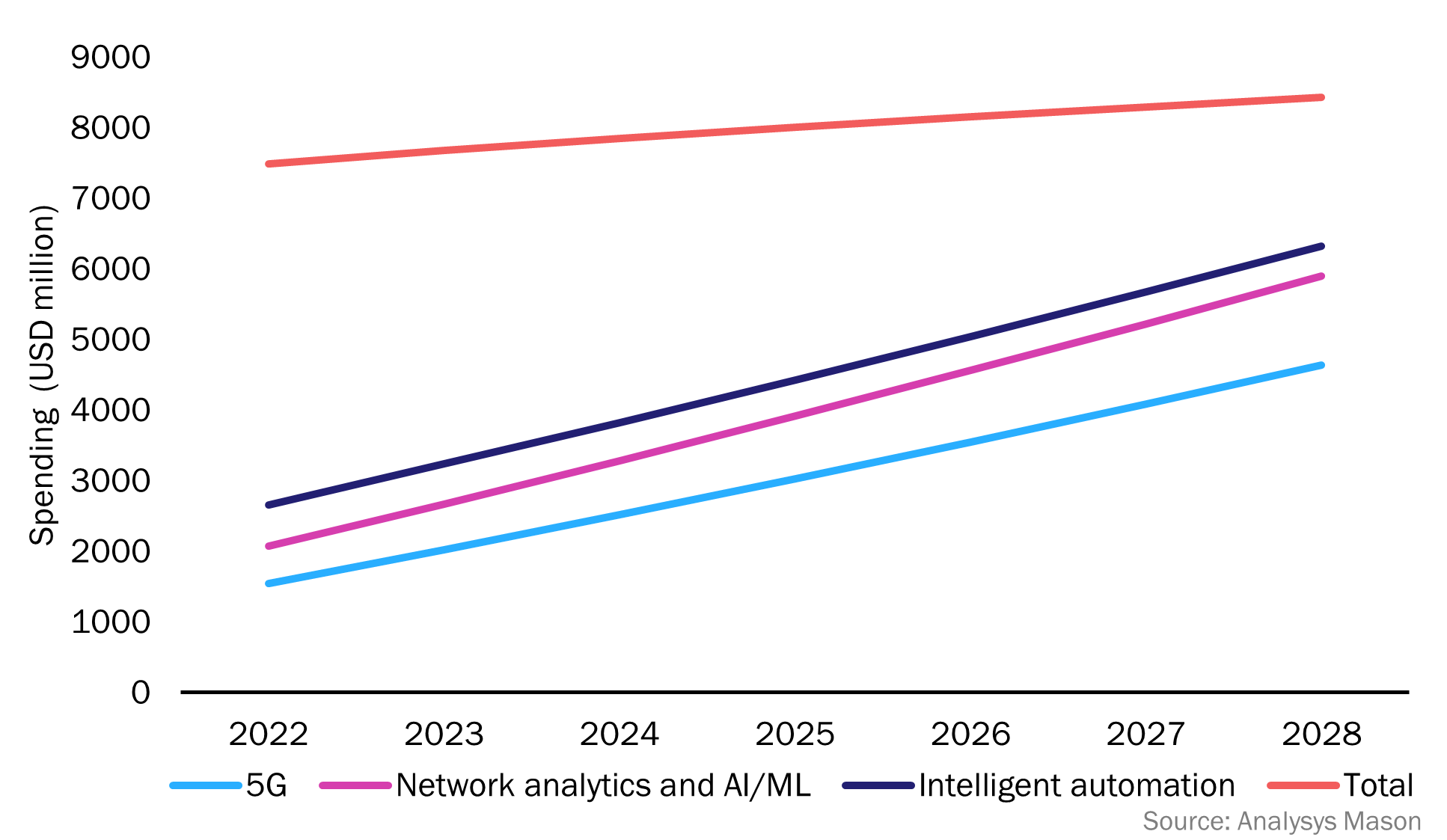5G SA roll-outs and new service complexities will fuel automated assurance market spending
Communications service providers (CSPs) are undergoing significant transformation, driven by the advent of complex 5G standalone (SA) technology, need for automation, and new data-driven operations models. These three factors are not only interconnected but will also serve as key drivers of spending in the automated assurance segment of the telecoms market in the next 5 years. This article provides brief insights into our automated assurance market forecast.
Figure 1: Forecast for CSP spending on key automated assurance market drivers, worldwide, 2022–2028

The complexity brought into the delivery of new services by the adoption of 5G technology will drive spending in the automated assurance segment
5G technology is now at an inflection point and expectations have increased accordingly. 5G SA is expected to revolutionise not only the telecoms market but various other industries, by enabling new applications and services. The industry has shifted from initial discussions focused on whether there is need for another incremental upgrade to the next generation (5G), to now actively exploring potential revenue sources from 5G technology. CSPs are at the point of making pivotal choices about how to change and improve their operational systems by adopting the right foundational technology that can handle not just what is needed now, but also what will be needed in the future as things evolve. This is a complex issue. Furthermore, the complexity of 5G networks do not only revolve around the adoption of new technologies such as virtualisation, softwarisation and cloudification but also around an explosion of data, seamless coordination across multi-system and multi-vendor solutions as well as scaling challenges. As the network becomes intent-based, programmable and segmented into slices, services become more complex to manage. All this is intensified by the expectation of a robust service experience from 5G, new features, new services and applications and a genuine overall differentiation from previous generations of networks. In this complex 5G environment, assurance systems are essential. They efficiently identify and resolve any issues that may arise by dealing with the massive volumes of data and coordinating and integrating multi-system, multi-vendor components. In this context, assurance systems are key in maintaining the high performance and reliability expected from 5G networks.
In the next 5 years, 5G will drive an increase in spending on automated assurance software and services. 5G-related automated assurance spending will reach USD4.6 billion by 2028 and will account for 55% of all automated assurance costs as CSPs start to deploy 5G SA. Indeed, CSP spending on 5G-related automated assurance systems will grow at a CAGR of 15.5% between 2023 and 2028. Spending will increase as CSPs begin to transition to 5G SA and service providers in emerging regions initiate their 5G roll-outs (Figure 1).
The complexity and scale of 5G networks imposes a high degree of automation for efficient operations
Automation in telecoms involves the use of software tools and advanced algorithms to manage network operations with minimal human intervention. Automated assurance systems can monitor network performance in real-time, detect anomalies and initiate corrective actions without manual intervention. This not only improves operational efficiency but also enhances customer experience by ensuring consistent service quality. By 2028, intelligent automation-related spending in the automated assurance segment will account for a significant 75% of spending, growing at a CAGR of over 20% in the forecast period.
Automation reduces mistakes, speeds up the release of new features, and improves order fulfilment. This makes it vital for handling complex operations and providing great service. But moving to automation is not simple. It involves changes to hardware, reorganising the company, updating software, integrating BSS and OSS systems, using industry-standard APIs, adopting DevOps methods and using cloud computing and artificial intelligence/machine learning (AI/ML) technologies.
CSPs’ new operation models will be data driven and make extensive use of AL/ML technology as well as Generative AI (GenAI) models
Key enablers of intelligent automation are AI/ML, which, over the forecast period, will be integrated into various stages of the value chain. AI is powered by ML, and the fuel for ML is data. Within the telecoms infrastructure, OSS systems represent an invaluable treasure trove of data. Among these systems, assurance systems stand out as a vast repository of network and operational data. They hold immense potential for proactive AI-driven interventions aimed at resolving network issues before they adversely impact the customer experience. This will empower CSPs to leverage a broader range of data sources for advanced correlation and analysis, including pattern recognition and anomaly detection, leading to actionable insights.
The effectiveness of automated assurance systems therefore largely depends on the availability and quality of data. This is where data-driven operating models become crucial. These models leverage big data analytics to gain insights into network performance and customer behaviour. The insights derived can be used to optimize network operations, personalize customer services, and make informed business decisions.
In the next 5 years, we anticipate that network analytics and AI/ML-related spending will reach USD5.9 billion in this segment as adoption increases at a CAGR of 20% over the forecast period.
The interconnection between these three drivers is evident. 5G roll-outs increase network complexity and create a need for automation. Automation, in turn, relies on data-driven models for effective decision-making. Together, they create a synergistic effect that enhances the efficiency and competitiveness of telecoms operators.
In the current market context, these drivers are important for several reasons. First, they enable telecoms operators to manage the increasing complexity and scale of their networks efficiently. Second, they help improve service quality and customer experience, which are key differentiators in a highly competitive market. Finally, they facilitate informed decision-making and strategic planning, thereby enhancing business agility and market responsiveness.
In conclusion, 5G roll-outs, automation and data-driven operating models are not only interconnected but also serve as key drivers of spending in the automated assurance segment of the telecoms market. Their collective impact on operational efficiency, service quality and business agility makes them indispensable in the evolving telecoms landscape.
Article (PDF)
DownloadAuthor


